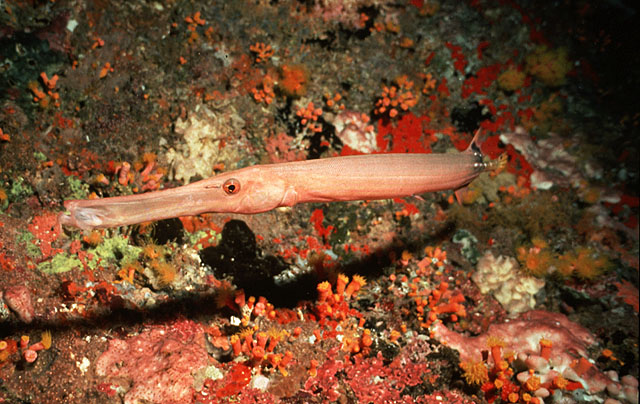| Aulostomidae (Trumpetfishes) |
| 80 cm TL (male/unsexed) |
|
reef-associated; marine; depth range 0 - 122 m |
| Indo-Pacific: East Africa to Hawaii and the Easter Island, north to southern Japan south to Lord Howe Island. Eastern Central Pacific: Panama, Revillagigedo Islands, Clipperton Island, Cocos Island, and Malpelo Island (Ref. 9275). |
|
Dorsal spines (total): 8-12; Dorsal soft rays (total): 24-27; Anal spines: 0-0; Anal soft rays: 26-29. Occurs in three basic color phases: uniformly brown to green, mottled brown to green, or uniformly yellow. First dorsal fin consists of a series of isolated spines, followed by a second dorsal fin consisting of rays. The second dorsal fin is shaped like the anal fin and is found directly above it. A black maxillary stripe usually present, but may be reduced; dorsal and anal fins light, but with a dark basal bar; caudal fin usually with two round black spots; a black spot at the base of each pelvic fin (Ref. 9825). |
| Found in clear, shallow water (Ref. 9275), in rocky and coral areas of protected and seaward reefs (Ref. 1602, 58302, 58534, 58652). Benthopelagic (Ref. 58302). Feeds on small fishes and shrimps (Ref. 9275). A slow-moving fish relying partly on stealth and camouflage to sneak up on unsuspecting prey. Often darts down vertically on its prey. Usually solitary (Ref. 48635). Minimum depth reported taken from Ref. 128797. |
|
Least Concern (LC); Date assessed: 27 November 2014 Ref. (130435)
|
| harmless |
|
Observed in greater frequency during the 1982-83 El Niño (Ref.9405). |
Source and more info: www.fishbase.org. For personal, classroom, and other internal use only. Not for publication.

